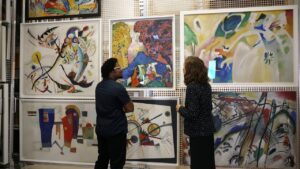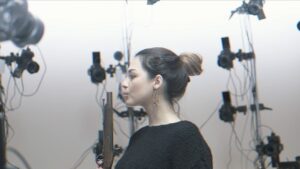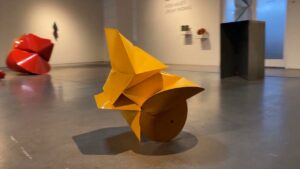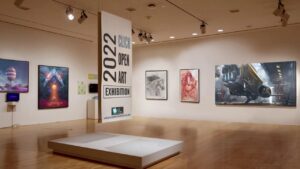Exhibition design is a form of art, and it is a unique way of communicating your message. Exhibit design involves careful planning, combining multiple creative elements, and understanding your audience. The process begins with brainstorming sessions and theme selection. Then, sketching begins, with elements planned to tell a story. After the initial sketches and layouts are completed, the exhibition designer works with the organizer to refine their ideas and budget. They will work with you to produce a final model that will reflect the intended message of your exhibition.
Exhibit design is a creative process, incorporating art, architecture, landscape, interior design, lighting, digital media, audiovisual engineering, and content writing. With its unique blend of disciplines, exhibit design has evolved over time. The material used for exhibit stands and the lighting are often influenced by the objects on display. The exhibit designer chooses the most appropriate material for the project, as well as the taste of the audience. Exhibit design also requires a interdisciplinary mindset and collaboration.
Exhibit designers must possess excellent communication skills, be willing to work with other team members, and be able to handle criticism. While changes are inevitable, designers should remain positive. The design process involves many iterations and it is critical to keep up with the changing needs of the client. Exhibit designers must also possess strong design, drawing, and software skills. In addition to these skills, exhibit designers must have a creative mind and work well under pressure.
While the art of exhibition design is varied, the main issues involve accessibility, health and safety, and the protection of the works themselves. Curators take into consideration how the objects look together and what story they tell. A large-scale exhibition such as Robert Mapplethorpe’s The Perfect Medium features more than 100 photographs, arranged chronologically and thematically. The design of the exhibition also includes several digital tools that help curators plan and visualize the arrangement.
The work of an exhibition designer requires careful planning and a clear understanding of the client’s message. They plan and design exhibits for venues and establish budgets. Exhibition designers work with clients throughout the design phase and often supervise the display installation. They may also work as a consultant for exhibit installation or other aspects of the process. A briefing meeting with the client is an essential part of the job. They must be able to communicate their client’s message clearly and effectively.
The art of exhibit design is a collaborative endeavor that integrates several disciplines. It is often a combination of disciplines, including architecture, digital media, lighting, interior design, and graphic design. Exhibits can be permanent or temporary. The designer is responsible for creating accessible spaces that will enhance the experience of visitors. Exhibits have to be appealing to the physical, intellectual, and emotional needs of the audience. However, the process is more involved than most people imagine.
Virtual art exhibition
Whether you are in search of a fresh talent or want to raise your artistic level in the marketplace, a virtual art exhibition is the perfect solution. A 3D virtual art gallery, such as VeeSpaces, offers fully customizable virtual booths with various features. Here are some tips that will help you set up your own virtual art exhibition. Here are a few ways to make your virtual art exhibition an instant success. Once you create your virtual booth, you can use your favorite photo, artwork, or any other type of media to promote your work.
If you’re interested in seeing how artists create and display their work, you’ll want to visit the Visionary Art Virtual Exhibition, which is free and open to the public. Ayjay has provided virtual art mentorship to all the participating artists, sharing his insights on both art and the Conscious Creators who create it. Artists featured in the exhibition include Visha Jayasena, Tobius Millar, Teddy Rhodes, and Naycha.
The emergence of virtual art exhibitions is a great way to showcase artwork from all over the world. Virtual art galleries are becoming more popular than ever because they provide viewers with a more interactive experience. Advances in technology and consumer trends are propelling the art world into a digital future. So, what’s holding you back from exhibiting your work? You might be surprised! So, get on board and get creative. And let us hope you’ll soon have a virtual art exhibition to show off your work.
A virtual art exhibition is similar to a physical one, but a virtual art gallery can be hosted on a computer, mobile device, or tablet. You can also host your exhibition on an online exhibition platform. But, a virtual art exhibition lacks many of the engagement factors that make them truly exciting. However, choosing the right platform can make them engaging and interactive. There are many benefits to hosting your art exhibition virtually. If you’re interested in exhibiting your work, start exploring these options today!
Interior design art project
Whether you’re a professional artist looking to add some unique pieces to your client’s home or a beginner who is just starting out, it’s important to take your time and do your research before beginning any interior design art project. First, you should consider the style and mood of the room. If the space is filled with activity, energetic artwork may be better suited. Otherwise, you should consider the color scheme to add a little flair.
A designer will be able to make your art collection tell a story through the layout of the room. Having a full inventory of your art will help you decide how to arrange it and how to position it. You can choose a triptych of related works or choose a large statement piece. The choice will depend on your taste and budget. A great interior designer will be able to help you choose the pieces that are most suitable for your home.
Once you’ve chosen your style, you’ll need to select colors that complement it. Interior paint colors can be overwhelming, but you can find some inspiration by searching for wall art. If you’re not sure what to do, you can browse images on the Internet and select one that inspires you. A good way to narrow down your selection is to choose a dominant colour, then select a few additional shades for accents. A great way to start is with an artwork that has a certain mood or style.
Your designer should take the time to understand the brief provided by your client. After all, interior design is an extremely personal journey, so it’s crucial to know what the client wants and what they want. Knowing these will help you make better design decisions and be sure to ask relevant questions during the initial consultation. The brief should serve as a springboard for your designer’s creative juices, as it will get them thinking about ideas and concepts. But remember, ideas are not final until they are fully discussed with your client.







